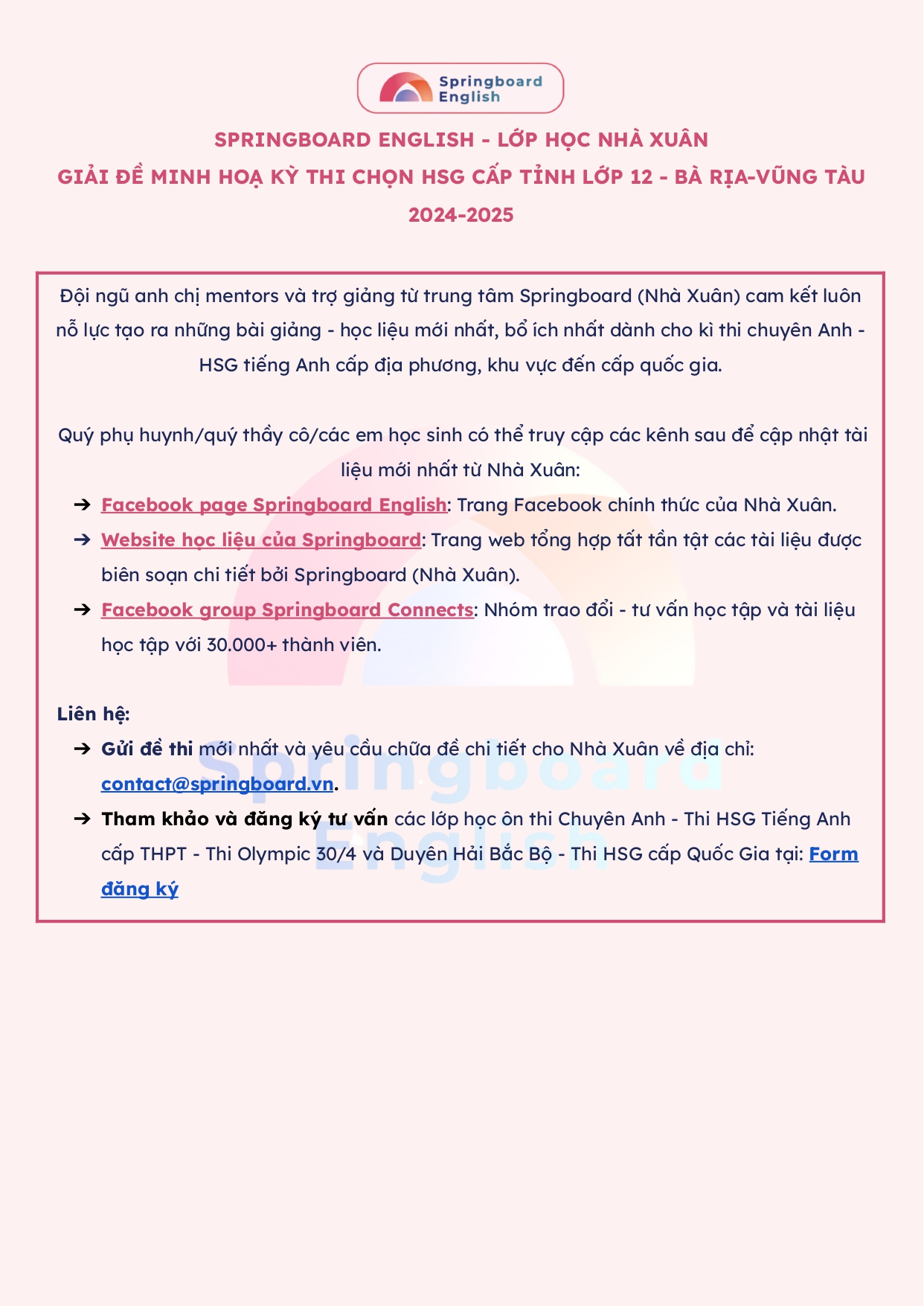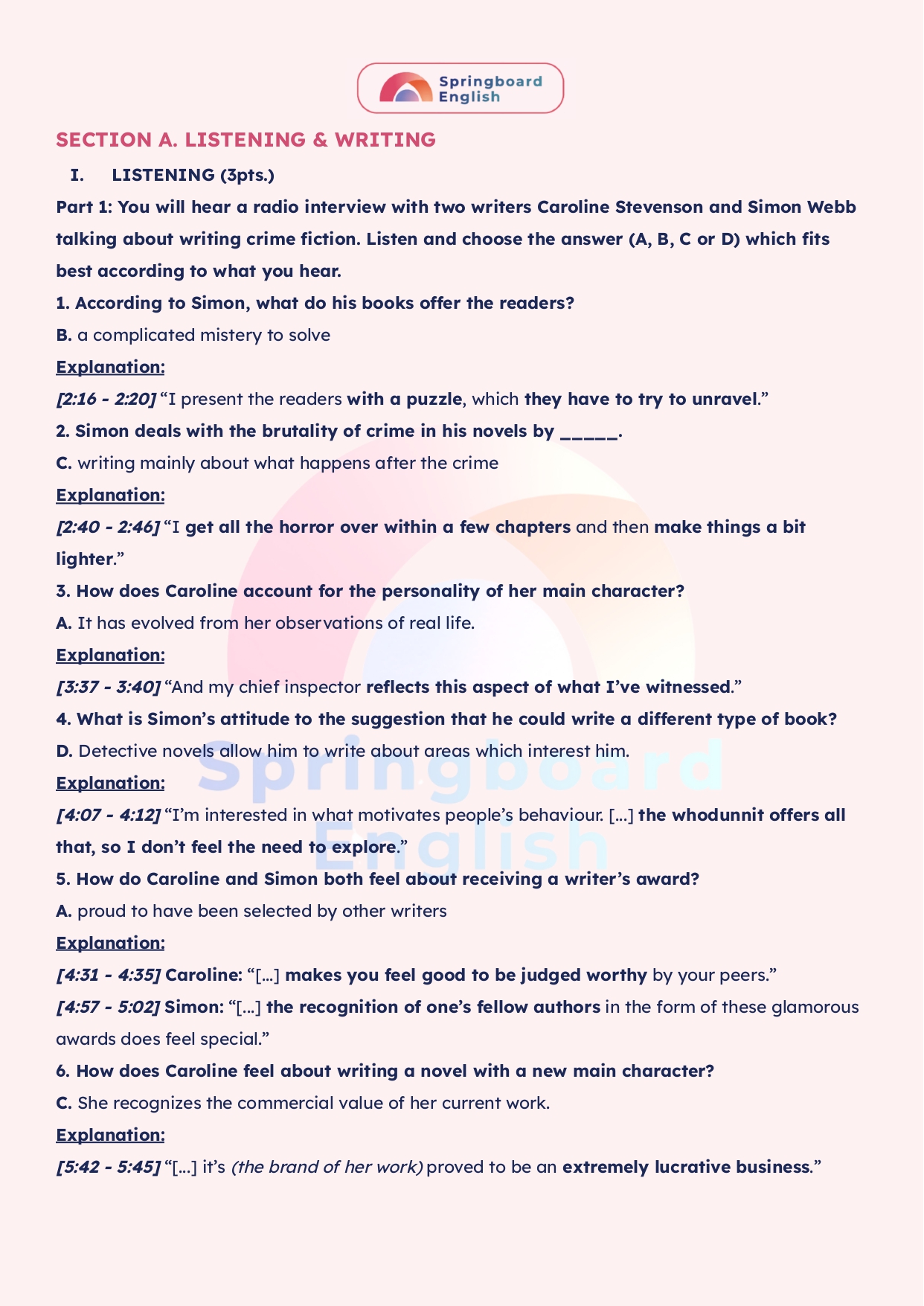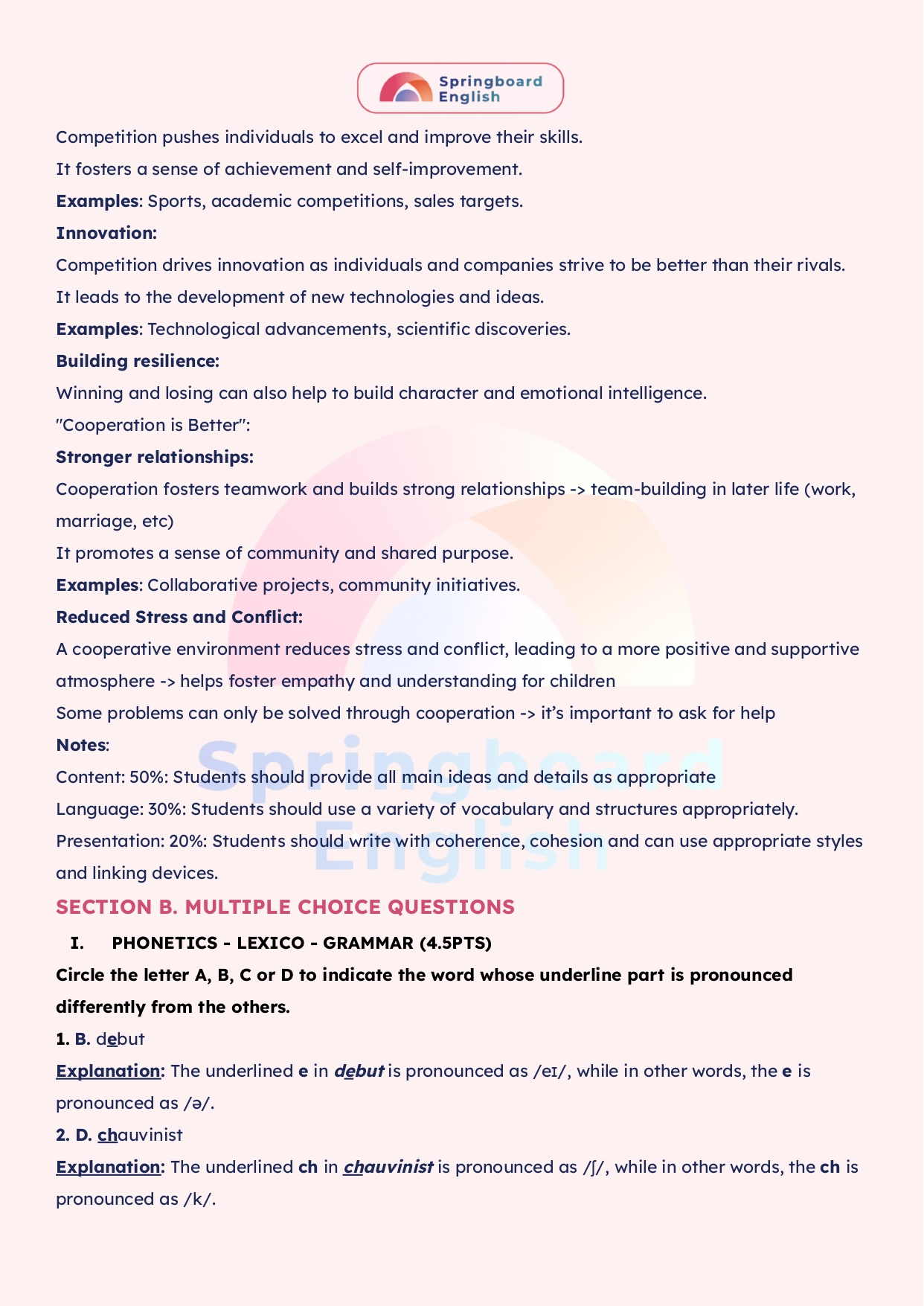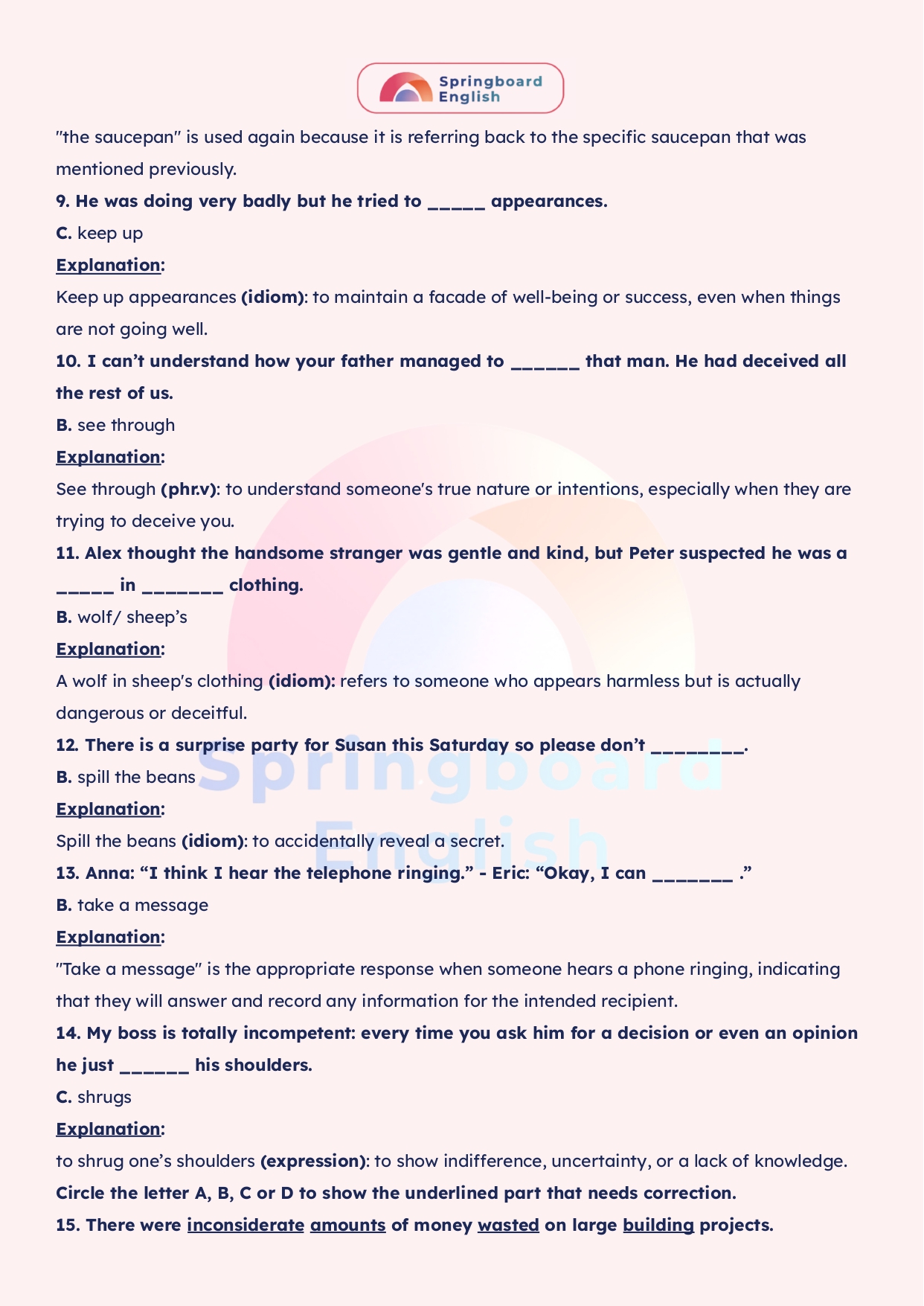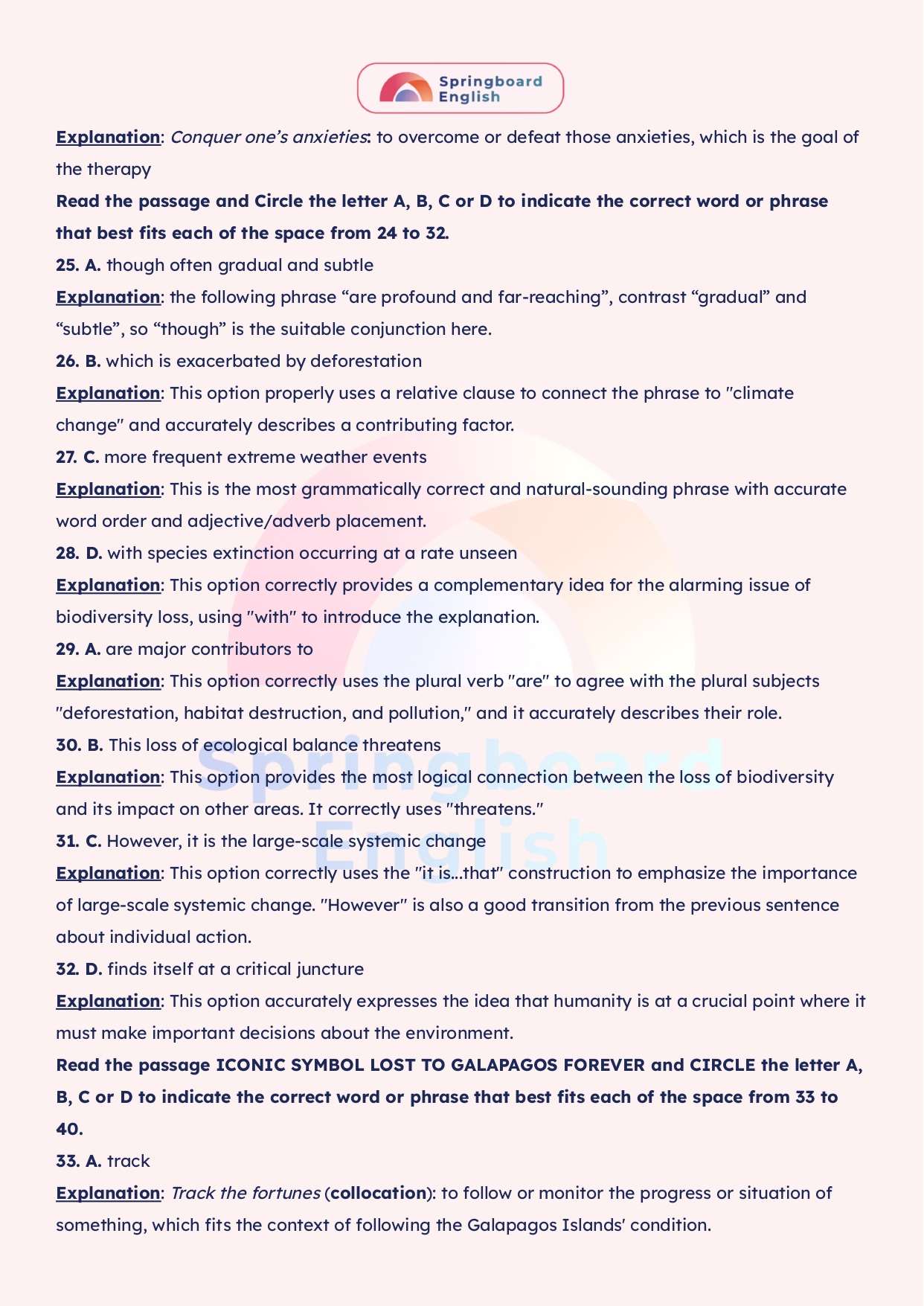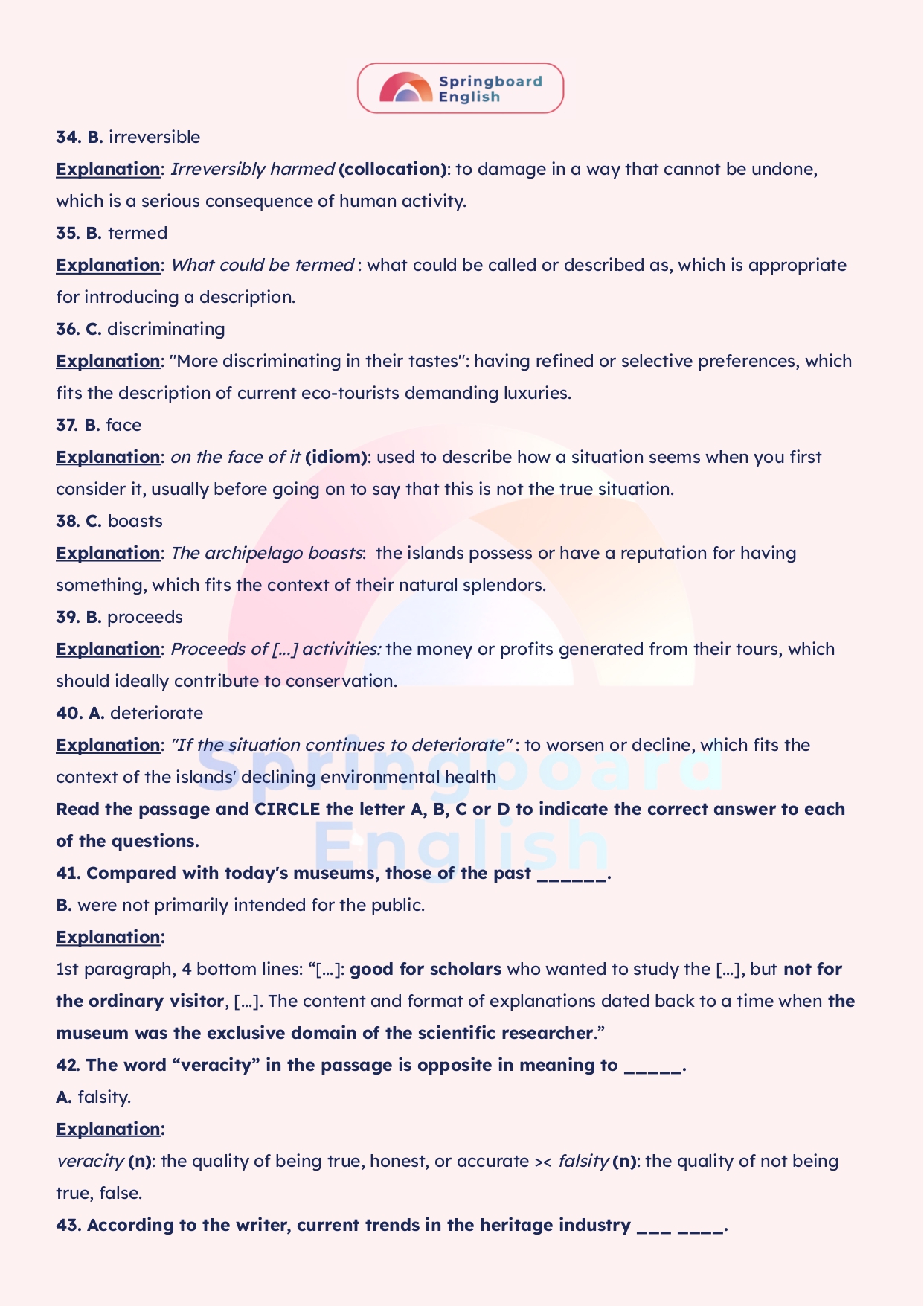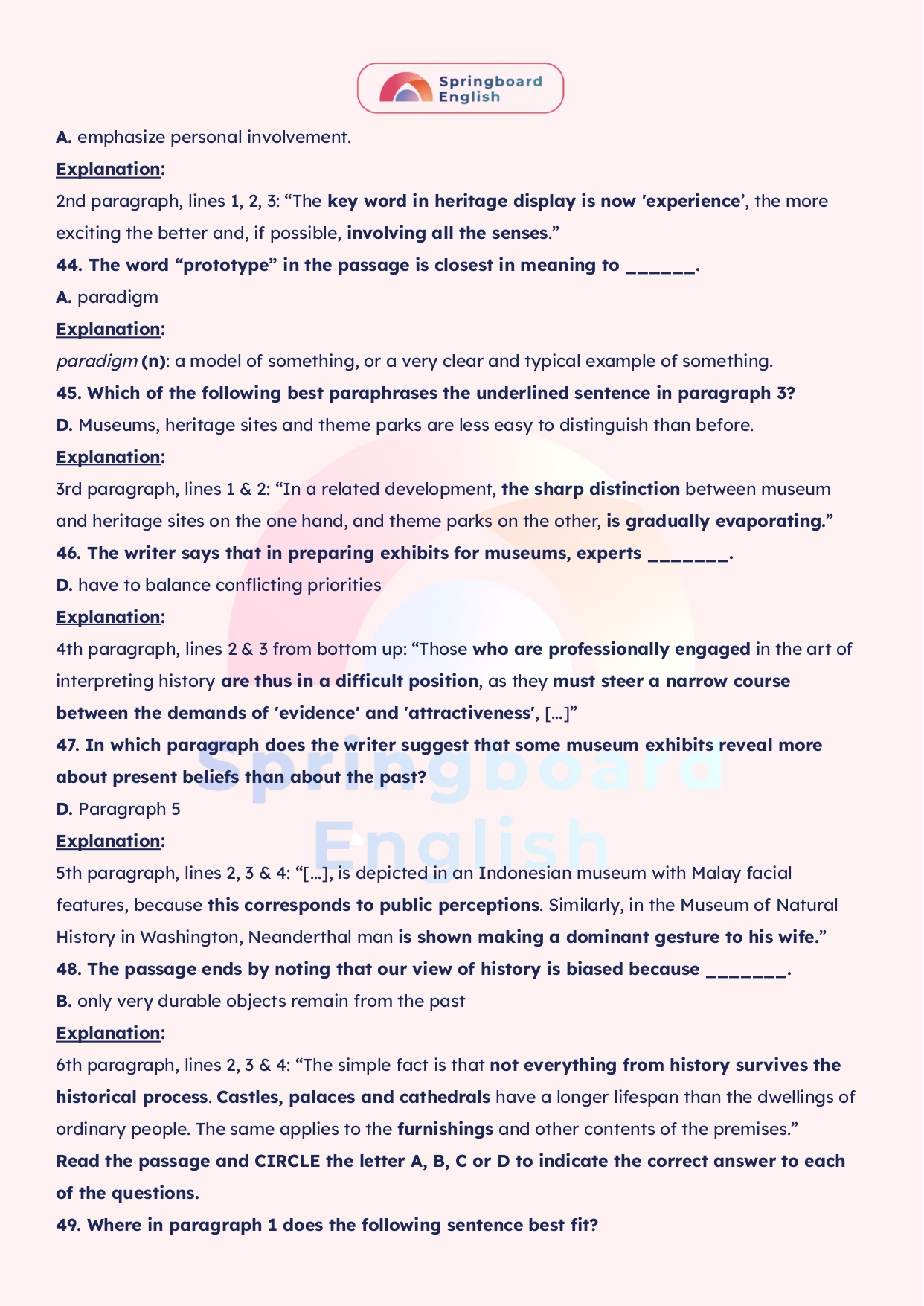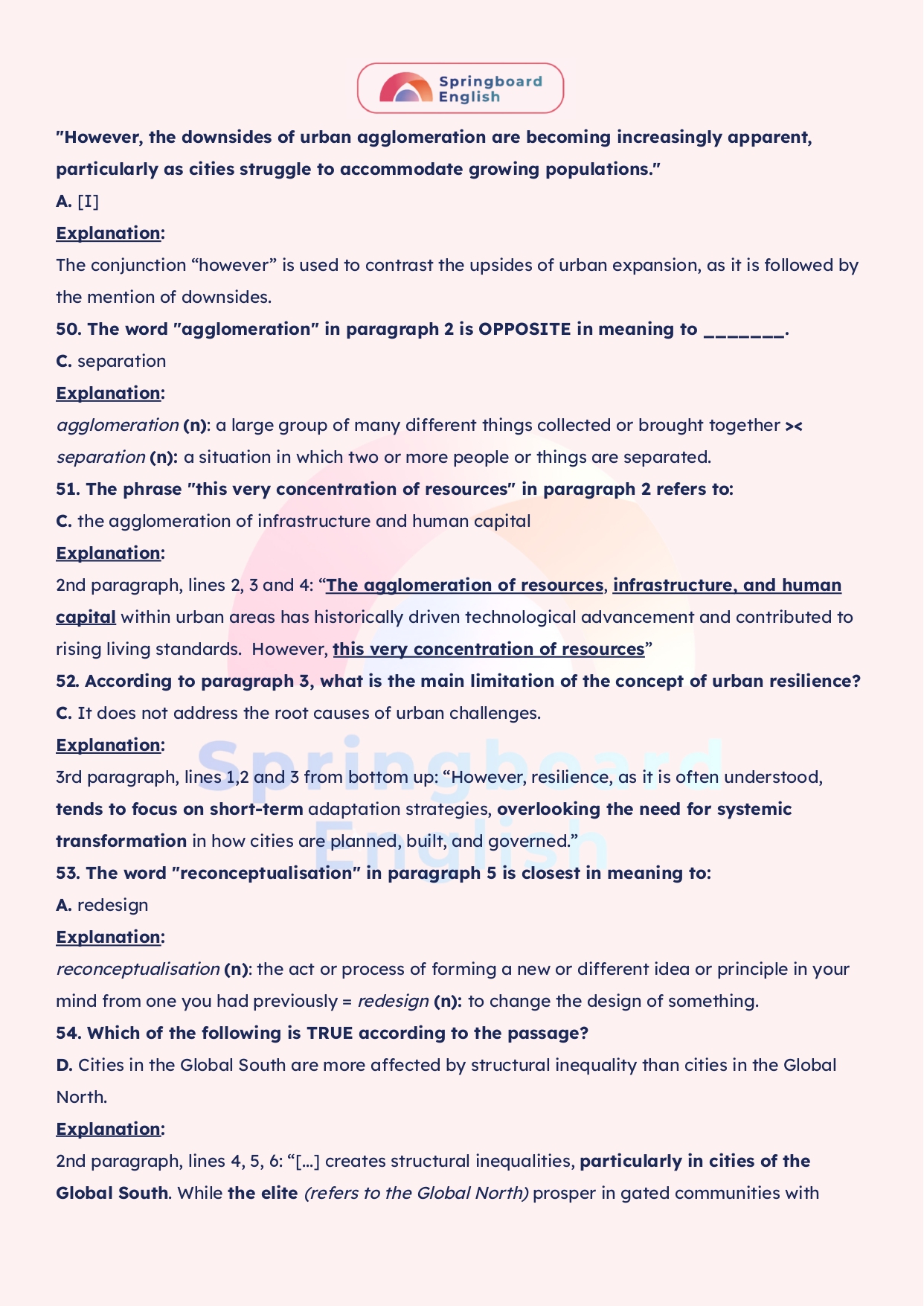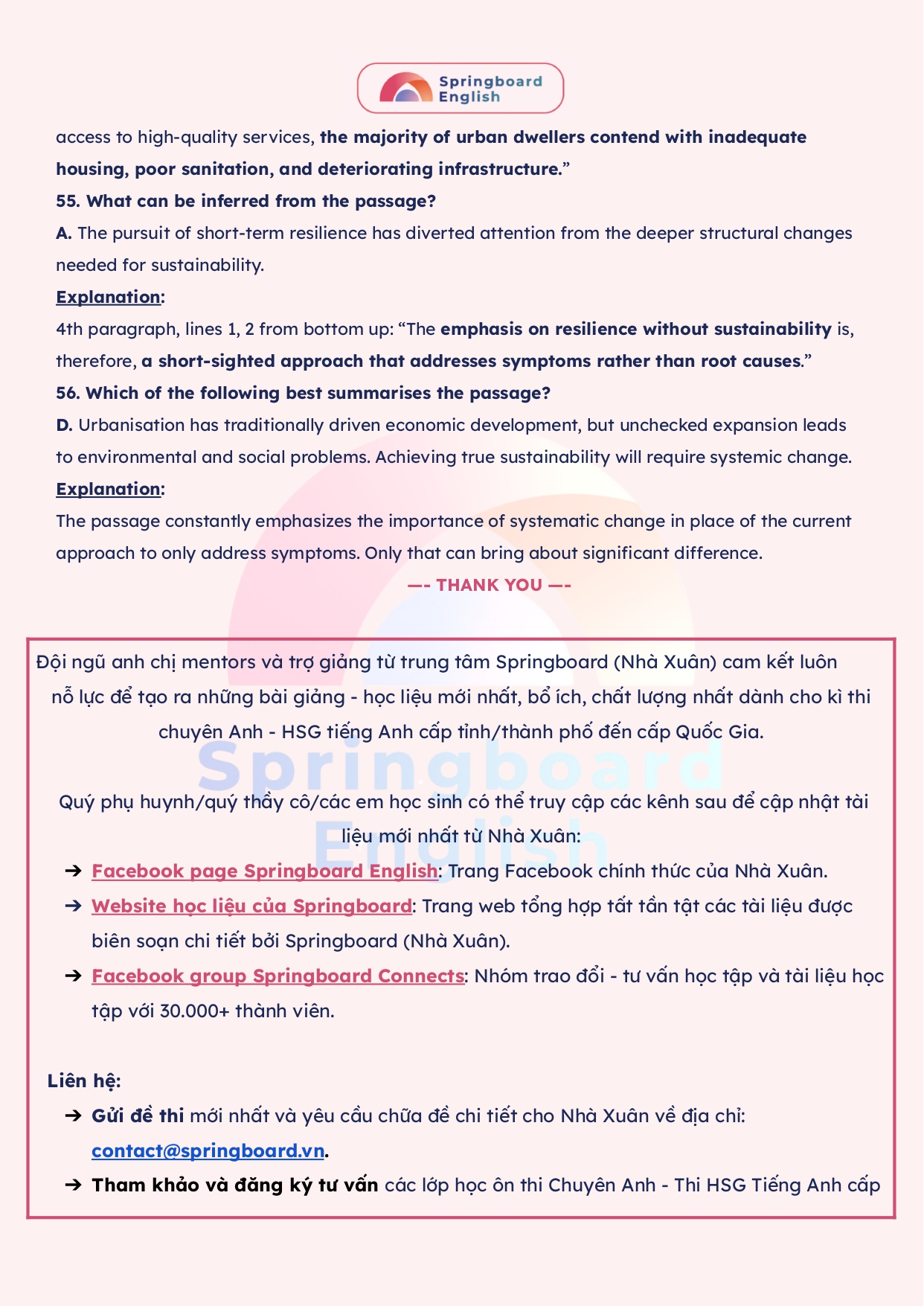Đề thi và Đáp án Chi tiết Kì thi Chọn HSG Tỉnh lớp 12 - Tỉnh Bà Rịa Vũng Tàu năm học 2024-2025
Trong bài viết này, Đội ngũ trung tâm Springboard (Nhà Xuân) xin chia sẻ đến các quý phụ huynh, thầy cô, các em học sinh Đề thi và Đáp án có giải thích chi tiết ở kì thi chọn học sinh giỏi tỉnh Tiếng Anh lớp 12 – tỉnh Bà Rịa Vũng Tàu năm học 2024-2025.
Phần đáp án chi tiết được giới thiệu ở bài viết này là tài liệu được biên soạn trực tiếp bởi đội ngũ chuyên môn Nhà Xuân, đồng thời là bản cập nhật mới nhất trong năm 2025.
Kéo xuống dưới cùng để xem hết đáp án có giải thích chi tiết.
Phần nghe - Đề thi chọn HSG lớp 12 tỉnh Bà Rịa Vũng Tàu năm học 2024-2025
Đề thi HSG Tiếng Anh lớp 12 - tỉnh Bà Rịa Vũng Tàu năm học 2024-2025
SỞ GIÁO DỤC VÀ ĐÀO TẠO TỈNH BÀ RỊA – VŨNG TÀU ĐỀ MINH HỌA (Đề thi gồm 8 trang) | KỲ THI HỌC SINH GIỎI LỚP 12 Môn: TIẾNG ANH Thời gian làm bài: 120 phút, không kể thời gian phát đề |
LISTENING – WRITING (học sinh làm bài trên giấy thi)
LISTENING (3pts.)
Part 1: You will hear a radio interview with two writers Caroline Stevenson and Simon Webb talking about writing crime fiction. Listen and choose the answer (A, B, C or D) which fits best according to what you hear.
According to Simon, what do his books offer the readers?
a social issue to think about B. a complicated mystery to solve
a shock which will thrill them D. a record of contemporary society
Simon deals with the brutality of crime in his novels by .
concentrating on the psychological aspects of the crime
describing the research which produces the evidence
writing mainly about what happens after the crime
referring to it in a light, almost humorous way
How does Caroline account for the personality of her main character?
It has evolved from her observations of real life.
It reflects the dark side of the criminal world.
It offers an alternative to the usual serious detective.
It allows Caroline to analyze a secretive lifestyle.
What is Simon’s attitude to the suggestion that he could write a different type of book?
He wishes he had written different books.
It is irrelevant which type of book he writes.
Only detective novels offer scope for deep feelings.
Detective novels allow him to write about areas which interest him.
How do Caroline and Simon both feel about receiving a writer’s award?
proud to have been selected by other writers
valued for having made a contribution to people’s lives
dismissive of the real significance of the prize
embarrassed about being pushed into the limelight
How does Caroline feel about writing a novel with a new main character?
She is unwilling to talk about her plans.
She is seriously tempted to do so.
She recognizes the commercial value of her current work.
She would feel lost if she abandoned her chief inspector.
(CAE online Test)
Part 2: You will hear a woman talking to a group of first – year science undergraduates about the developing science of nanotechnology. Listen and complete the sentences with a word or short phrase.
(Cambridge IELTS)
WRITING (3 pts.)
Some people think that competition at work, at school and in daily life is a good thing. Others believe that we
should try to cooperate more, rather than competing against each other.
Write an essay (of about 300 words) to discuss both these views and give your own opinion.
MULTIPLE CHOICE QUESTION (Học sinh làm bài trên phiếu trả lời trắc nghiệm)
PHONETICS – LEXICO – GRAMMAR (4.5 pts)
Circle the letter A, B, C or D to indicate the word whose underline part is pronounced differently from the others.
1. A. efface | B. debut | C. enlist | D. deter |
2. A. chronicle | B. choleric | C. chimera | D. chauvinist |
Circle the letter A, B, C or D to indicate the word with the stress pattern different from that of the others.
3. A. influenza | B. controversial | C. demonstrative | D. preferential |
4. A. trigonometry | B. explanatory | C. immediately | D. democracy |
Circle the letter A, B, C or D to show the underlined part that needs correction
―Which is more important: luck or effort?‖ – ―Luck is effort.
of the same importance B. the same importance as
as the same importance as D. of the same importance as
I’d sooner you badly in the last exam.
didn’t do B. hadn’t done C. couldn’t do D. wouldn’t have done
It is imperative that the world towards a solution to global warming before the weather patterns of the world are disrupted irreparably.
works B. work C. to work D. have worked
Poor Pinocchio ran quickly to fireplace, where saucepan was boiling and was going to take off lid to see what was in it, but saucepan was only painted on the wall.
the/ a/ the/ the B. a/ a/ the/ the C. the/ the/ the/ a D. a/ the/ a/ the
He was doing very badly but he tried to appearances.
hold on B. stick to C. keep up D. make out
I can’t understand how your father managed to that man. He had deceived all the rest of us.
see off B. see through C. see to D. see out
Alex thought the handsome stranger was gentle and kind, but Peter suspected he was a in clothing.
sheep / wolf’s B. wolf / sheep’s C. tiger / lion’s D. lion / tiger’s
There is a surprise party for Susan this Saturday so please don’t
run of the mill B. spill the beans C. get the ball rolling D. find my feet
Anna: ―I think I hear the telephone ringing.‖ – Eric: ―Okay, I can .‖
take a hint B. take a message C. make a call D. give you a ring
My boss is totally incompetent: every time you ask him for a decision or even an opinion he just his shoulders.
cranes B. swivels C. shrugs D. knits
CIRCLE the letter A, B, C or D to show the underlined part that needs correction.
There were inconsiderate amounts of money wasted on large building projects.
inconsiderate B. amounts C. wasted D. building
The production of different kinds of artificial materials are essential to the conservation of our natural resources.
The production B. artificial C. are essential D. to
Circle the letter A, B, C or D to indicate the sentence that is closest in meaning or best combines the pairs of sentences given in each of the following questions.
The first runner came in. The second runner followed him closely.
The first runner who closely followed by the second came in.
The second runner closely followed the first one came in.
The second runner who was closely followed came in with the first one.
In came the first runner, closely followed by the second.
It is much easier to walk home from here than get on a crowded minibus.
If the minibus is full, I will probably just choose to walk home from here.
While it’s not easy to get on a crowded minibus, it’s better than going home on foot.
It is a lot more difficult to squeeze into a full minibus than to go home from here on foot.
People generally walk home from here rather than use the minibuses, because they are always full.
III. READING (9.5 pts.)
Read the following announcement and circle the letter A, B, C or D to indicate the option that best fits each of the numbered blanks from 19 to 24
THE FEAR OF FLYING clinic
Do you postpone or avoid travelling because you’d rather not fly?
Does the thought of taking off in an aeroplane make you come out in a cold (19) ?
Do you have nightmares about flying?
If you answered yes to any of those questions, join the club.
YOU ARE NOT ALONE
One in seven Europeans (20) avoids commercial air-travel.
Your fear of flying is real and important. It is especially significant in this fast-paced world, where more and more of us are expected to fly for business.
If the fear of flying has led you to turn down jobs or promotions, to put off visits to family members who live far away, or to (21) road maps or bus and train schedules when planning holidays, know that help is available.
HOW WE CAN HELP YOU
We utilize various aviation facilities at several airports around the world. (22) the leadership of Jeanne McElhatton and a team of highly qualified aviation professionals still active in their field, we have achieved a consistent success rate of over 90% in helping people overcome their fear of flying.
Our mission is to (23) misconceptions about air travel. We wish to replace irrational fears with solid facts.
We employ licensed behavioral therapists who work closely with fearful fliers in developing techniques to
(24) their anxieties. Our role is to educate people, but if we simply educate without facilitating a change in attitude, it won’t help the fearful fliers. Ours is really a two-pronged approach-education plus behavioral change.
(Adapted from Upstream)
A. sweat B. shoulder C. head D. feet
A. carefully B. deliberately C. narrowly D. bitterly
A. gloss over B. dwell over C. pore over D. snow over
A. From B. Under C. In D. With
A. validate B. challenge C. discredit D. debunk
A. provoke B. aggravate C. experience D. conquer
Read the passage and CIRCLE the letter A, B, C or D to indicate the correct word or phrase that best fits each of the space from 24 to 32.
The environment, a fragile and intricate system, is increasingly under threat from human activities. The consequences of environmental degradation, (25) , are profound and far-reaching, impacting not only ecosystems but also human societies. One of the most pressing environmental concerns today is climate change, (26) , the burning of fossil fuels, and the industrialization that has fueled modern economies. The steady rise in global temperatures has led to (27) , such as hurricanes, floods, and droughts, which in turn disrupt agriculture, displace populations, and strain resources.
Furthermore, the loss of biodiversity is another alarming issue, (28) since the last mass extinction event. Deforestation, habitat destruction, and pollution, particularly of oceans and freshwater sources, (29)
this crisis. When species disappear, entire ecosystems can become destabilized, which has a cascading effect on the environment. (30) food security, water supply, and even the health of the global economy, particularly in regions heavily reliant on natural resources.
The responsibility for addressing environmental issues rests not only with governments and corporations but also with individuals. Small changes, such as reducing energy consumption, recycling, and supporting sustainable practices, can collectively make a significant difference. (31) , driven by stringent policies and global cooperation, that will ultimately dictate the future of the planet. The urgent need for environmental protection cannot be overstated, as the decisions made today will shape the quality of life for generations to come. Thus, humanity (32) with the opportunity to either mitigate the damage or allow the environment to deteriorate beyond repair.
A. though often gradual and subtle B. which are often gradual and subtle
due to being often gradual and subtle D. as well as often gradual and subtle
A. is exacerbated by deforestation B. which is exacerbated by deforestation
exacerbating deforestation D. to have exacerbated deforestation
A. more extreme weather frequent events B. more extremely frequent weather events
more frequent extreme weather events D. more frequently extreme weather events
A. when species extinction occurring at an unseen rate
because species are becoming extinct at a rate unseen
for species which become extinct at an unseen rate
with species extinction occurring at a rate unseen
A. are major contributors to B. as major contributors to
contributing mainly to D. being contributed manly to
A. This threat of ecological balance loses B. This loss of ecological balance threatens
This ecological balance threatens the loss of D. This loss of ecological threats balances
A. However, the large-scale systemic change
Therefore, if the large-scale systemic changes
However, it is the large-scale systemic change
Additionally, the large-scale systemic which changes
A. finding themselves critical juncture B. is finding a critical juncture for itself
found itself a critical juncture D. finds itself at a critical juncture
Read the passage ICONIC SYMBOL LOST TO GALAPAGOS FOREVER and CIRCLE the letter A, B, C or D to indicate the correct word or phrase that best fits each of the space from 33 to 40.
The news of the demise of Lonesome George, thought to be the last-surviving member of his species, Geochelone Abingdoni, is likely to come as a shock to those who (33) the fortunes of Galapagos, the habitat that inspired the Darwinian theory of evolution, and one that is now genuinely under real threat and in danger of being (34) harmed by human activity, with the main source of damage being tourism.
Early visitor to the archipelago were what could be (35) true nature-loving tourists, a group which did little collective or individual harm to the islands and did not interfere with the fragile balance of the ecosystem. However, in more recent times, eco-tourism has grown to enjoy almost cult-like popularity. Eco- tourists are a very different beast though and are rather more (36) in their tastes. Therefore, while, on the (37) of it, they come to marvel at the natural splendours the archipelago (38) , they do so only on the understanding that their comfort will not be sacrificed, requiring tour providers to take special measures to accommodate their more discerning tastes.
Large companies are best positioned to offer these eco-tourists the luxuries they have come to expect, but their popularity with visitors is side-lining local operators, a proportion of whose revenues goes towards the upkeep and conservation of the precious ecosystem. Sadly, the large international tour companies are far less benevolent with the (39) of their activities, which results in a double-edged sword situation whereby, due to large numbers of tourists, more and more of the islands’ habitat is being disturbed while, at the same time, less funding is being made available to conserve the ecosystem.
If the situation continues to (40) , Lonesome George may be but the first of many rare and endangered creatures to disappear.
(Succeed in Cambridge English: Proficiency)
A. track B. pursue C. observe D. grasp
A. irrespectively B. irreversibly C. irrelevantly D. irreverently
A. coined B. termed C. stated D. shared
A. delineating B. deliberating C. discriminating D. debilitating
A. front B. face C. cusp D. side
A hosts B. lends C. boasts D. homes
A. results B. proceeds C. finances D. costs
A. deteriorate B. disrepair C. decompose D. distress
Read the passage and CIRCLE the letter A, B, C or D to indicate the correct answer to each of the questions.
The Development of Museums
The conviction that historical relics provide infallible testimony about the past is rooted in the nineteenth and early twentieth centuries, when science was regarded as objective and value free. As one writer observes: ‘Although it is now evident that artefacts are as easily altered as chronicles, public faith in their veracity endures: a tangible relic seems ipso facto real. Such conviction was, until recently, reflected in museum displays. Museums used to look – and some still do- much like storage rooms of objects packed together in showcases: good for scholars who wanted to study the subtle differences in design, but not for the ordinary visitor, to whom it all looked alike. Similarly, the information accompanying the objects often made little sense to the lay visitor. The content and format of explanations dated back to a time when the museum was the exclusive domain of the scientific researcher.
Recently, however, attitudes towards history and the way it should be presented have altered. The key word in heritage display is now ‘experience’, the more exciting the better and, if possible, involving all the senses. Good examples of this approach in the UK are the Jorvik Centre in York; the National Museum of
Photography, Film and Television in Bradford; and the Imperial War Museum in London. In the US the trend emerged much earlier: Williamsburg has been a prototype for many heritage developments in other parts of the world. No one can predict where the process will end. On so-called heritage sites the re-enactment of historical events is increasingly popular, and computers will soon provide virtual reality experiences, which will present visitors with a vivid image of the period of their choice, in which they themselves can act as if part of the historical environment. Such developments have been criticized as an intolerable vulgarization, but the success of many historical theme parks and similar locations suggests that the majority of the public does not share this opinion.
In a related development, the sharp distinction between museum and heritage sites on the one hand, and theme parks on the other, is gradually evaporating. They already borrow ideas and concepts from one another. For example, museums have adopted story lines for exhibitions, sites have accepted ‘theming’ as a relevant tool, and theme parks are moving towards more authenticity and research-based presentations. In zoos, animals are no longer kept in cages, but in great spaces, either in the open air or in enormous greenhouses, such as the jungle and desert environments in Burgers’ Zoo in Holland. This particular trend is regarded as one of the major developments in the presentation of natural history in the twentieth century.
Theme parks are undergoing other changes, too, as they try to present more serious social and cultural issues, and move away from fantasy. This development is a response to market forces and, although museums and heritage sites have a special, rather distinct, role to fulfil, they are also operating in a very competitive environment, where visitors make choices on how and where to spend their free time. Heritage and museum experts do not have to invent stories and recreate historical environments to attract their visitors: their assets are already in place. However, exhibits must be both based on artefacts and facts as we know them, and attractively presented. Those who are professionally engaged in the art of interpreting history are thus in a difficult position, as they must steer a narrow course between the demands of ‘evidence’ and ‘attractiveness’, especially given the increasing need in the heritage industry for income-generating activities.
It could be claimed that in order to make everything in heritage more ‘real, historical accuracy must be increasingly altered. For example, Pithecanthropus erectus is depicted in an Indonesian museum with Malay facial features, because this corresponds to public perceptions. Similarly, in the Museum of Natural History in Washington, Neanderthal man is shown making a dominant gesture to his wife. Such presentations tell us more about contemporary perceptions of the world than about our ancestors. There is one compensation, however, for the professionals who make these interpretations: if they did not provide the interpretation, visitors would do it for themselves, based on their own ideas, misconceptions and prejudices. And no matter how exciting the result, it would contain a lot more bias than the presentations provided by experts.
Human bias is inevitable, but another source of bias in the representation of history has to do with the transitory nature of the materials themselves. The simple fact is that not everything from history survives the historical process. Castles, palaces and cathedrals have a longer lifespan than the dwellings of ordinary people. The same applies to the furnishings and other contents of the premises. In a town like Leyden in Holland, which in the seventeenth century was occupied by approximately the same number of inhabitants as today, people lived within the walled town, an area more than five times smaller than modern Leyden. In most of the houses several families lived together in circumstances beyond our imagination. Yet in museums, fine period rooms give only an image of the lifestyle of the upper class of that era. No wonder that people who stroll around exhibitions are filled with nostalgia; the evidence in museums indicates that life was so much better in the past. This notion is induced by the bias in its representation in museums and heritage centers.
(Cambridge English IELTS)
Compared with today’s museums, those of the past .
did not present history in a detailed way B. were not primarily intended for the public
were more clearly organized D. preserved items with greater care
The word ―veracity‖ in the passage is opposite in meaning to .
falsity B. identification C. exquisiteness D. clarity
According to the writer, current trends in the heritage industry .
emphasize personal involvement. B. have their origins in York and London.
rely on computer images. D. reflect minority tastes.
The word ―prototype‖ in the passage is closest in meaning to .
paradigm B. necessity C. commitment D. incarnation
Which of the following best paraphrases the underlined sentencein paragraph 3?
Museums, heritage sites and theme parks often work in close partnership.
Museums, heritage sites and theme parks try to preserve separate identities.
Museums, heritage sites and theme parks have similar exhibits.
Museums, heritage sites and theme parks are less easy to distinguish than before.
The writer says that in preparing exhibits for museums, experts .
should pursue a single objective
have to do a certain amount of language translation
should be free from commercial constraints
have to balance conflicting priorities
In which paragraph does the writer suggest that some museum exhibits reveal more about present beliefs than about the past?
Paragraph 2 B. Paragraph 3 C. Paragraph 4 D. Paragraph 5
The passage ends by noting that our view of history is biased because .
we fail to use our imagination
only very durable objects remain from the past
we tend to ignore things that displease us
museum exhibits focus too much on the local area
Read the passage and CIRCLE the letter A, B, C or D to indicate the correct answer to each of the questions.
The Paradox of Urban Expansion
Urban expansion has long been heralded as a catalyst for economic growth, innovation, and cultural exchange. (I)Yet, the rapid pace at which cities are growing has raised a series of contradictions that urban planners, economists, and environmentalists are struggling to reconcile. (II)
On one hand, cities are centres of opportunity, housing millions of people who flock to them in search of employment, education, and improved standards of living. (III)The agglomeration of resources, infrastructure, and human capital within urban areas has historically driven technological advancement and contributed to rising living standards. (IV) However, this very concentration of resources creates structural inequalities, particularly in cities of the Global South. While the elite prosper in gated communities with access to high-quality services, the majority of urban dwellers contend with inadequate housing, poor sanitation, and deteriorating infrastructure. This disparity fosters resentment and threatens the social fabric.
Equally problematic is the environmental cost of unregulated urban expansion. Cities are responsible for approximately 80% of global energy consumption and generate the bulk of the world’s carbon emissions. Yet, they remain paradoxically vulnerable to the effects of climate change. Coastal cities face rising sea levels, while inland urban centres struggle with air pollution, heat waves, and diminishing water supplies. Urban resilience is frequently touted as the solution to these challenges. However, resilience, as it is often understood, tends to focus on short-term adaptation strategies, overlooking the need for systemic transformation in how cities are planned, built, and governed.
Critics argue that the prevailing narrative around urban resilience has masked deeper issues of sustainability. While resilience planning emphasises robustness in the face of external shocks—such as natural disasters or economic downturns—sustainability encompasses a broader, long-term vision of urban development that prioritises equity, environmental stewardship, and social cohesion. The emphasis on resilience without sustainability is, therefore, a short-sighted approach that addresses symptoms rather than root causes.
What is required, many experts argue, is a reconceptualisation of urbanisation itself. Instead of viewing cities as isolated hubs of economic activity, they must be understood within the larger context of regional and global ecosystems. A truly sustainable city is one that balances human needs with environmental limitations, reduces consumption, and ensures that all citizens—not just the privileged few—benefit from urban life. Achieving this vision, however, will require profound changes in both public policy and
societal values, as well as a concerted effort to dismantle the entrenched structures of inequality that continue to plague urban areas globally.
Where in paragraph 1 does the following sentence best fit?
“However, the downsides of urban agglomeration are becoming increasingly apparent, particularly as cities struggle to accommodate growing populations.”
[I] B. [II] C. [III] D. [IV]
The word “agglomeration” in paragraph 2 is OPPOSITE in meaning to .
collection B. clustering C. separation D. accumulation
The phrase “this very concentration of resources” in paragraph 2 refers to:
technological advancements
the housing of millions of people
the agglomeration of infrastructure and human capital
rising living standards
According to paragraph 3, what is the main limitation of the concept of urban resilience?
It focuses too much on environmental issues.
It is based on unsustainable economic models.
It does not address the root causes of urban challenges.
It promotes inequality among urban dwellers.
The word “reconceptualisation” in paragraph 5 is closest in meaning to:
redesign B. postponement C. reinforcement D. rejection
Which of the following is TRUE according to the passage?
Cities in coastal areas are less vulnerable to the effects of climate change compared to inland cities.
Urban resilience has successfully tackled the environmental challenges of climate change.
Sustainability planning is primarily concerned with economic growth and technological innovation.
Cities in the Global South are more affected by structural inequality than cities in the Global North.
What can be inferred from the passage?
The pursuit of short-term resilience has diverted attention from the deeper structural changes needed for sustainability.
Urban planning that focuses on human capital development will naturally lead to sustainability.
Technological innovation is the key to solving the environmental problems caused by rapid urbanisation.
The future of cities lies in balancing economic growth with resilience and sustainability.
Which of the following best summarises the passage?
Urbanisation in the Global South faces more challenges than in the Global North, primarily due to climate change and resource inequality.
Cities are unsustainable due to the overwhelming pressure of migration and consumption, and governments should discourage further urbanization
Resilience-focused planning is sufficient for managing the challenges of urbanisation, and sustainability is an overhyped concept.
Urbanisation has traditionally driven economic development, but unchecked expansion leads to environmental and social problems. Achieving true sustainability will require systemic change.
The end
File PDF - Đề thi HSG Tiếng Anh lớp 12 tỉnh Bà Rịa Vũng Tàu năm học 2024-2025
File PDF đề thi
Lời kết
Cảm ơn quý phụ huynh, thầy cô, và các em học sinh đã tham khảo tài liệu được biên soạn bởi Nhà Xuân.
Với nỗ lực để luôn tạo ra những bài giảng – học liệu hay nhất dành cho kì thi chuyên Anh – HSG tiếng Anh cấp tỉnh/thành phố đến cấp Quốc Gia, đội ngũ mentors trung tâm Springboard (Nhà Xuân) luôn biên soạn những tài liệu mới nhất với giải thích tận tâm – chi tiết.
Quý phụ huynh/ quý thầy cô/các em học sinh có thể truy cập các kênh sau để cập nhật tài liệu mới nhất từ Nhà Xuân:
- Facebook page Springboard English: Trang Facebook chính thức của Nhà Xuân
- Facebook group Springboard Connects: Nhóm trao đổi – tư vấn học tập, và tài liệu học tập với 30.000+ thành viên
- Website học liệu – springboard.vn :Trang web tổng hợp tất tần tật các tài liệu được biên soạn chi tiết bởi Springboard (Nhà Xuân).
Liên hệ:
- Gửi đề thi mới nhất cho Nhà Xuân về địa chỉ: contact@springboard.vn
- Tham khảo và đăng ký tư vấn các lớp học ôn thi Chuyên Anh – Thi HSG Tiếng Anh cấp THPT – Thi Olympic 30/4 và Duyên Hải Bắc Bộ – Thi HSG cấp Quốc Gia tại: Form đăng ký tư vấn.
Thân ái,
Đội ngũ trung tâm Springboard (Nhà Xuân)



